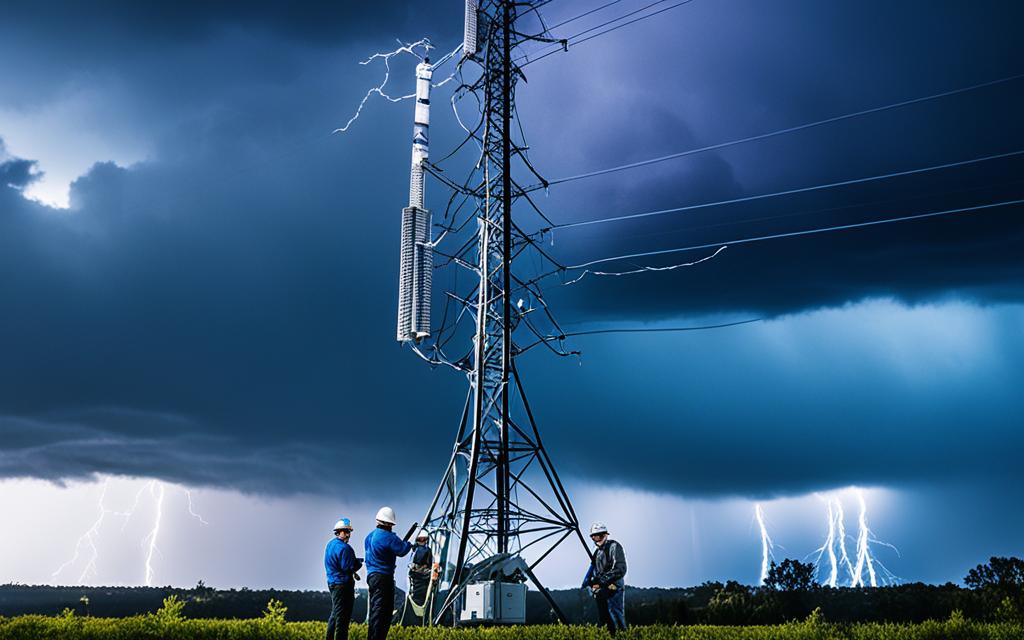A key attribute of resilience is the ability of an item to adapt to a situation and overcome a problem to the point where it returns as close to how it was before the event occurred. In the case of networking, network availability is an important business asset and organizations face worst-case scenarios such as loss of internet access, wireless communications, and the ability to connect with employees, offices, and customers. Technology disaster recovery (DR) plans play an essential role in protecting the integrity of voice and data communications networks, but do they ensure network resilience?
Factors that can pose risks and threats to network integrity include severe weather, power loss or equipment failure, software failure, human error, sabotage or cybersecurity breaches, environmental disruptions, and construction. When building a network DR plan to achieve resilience, teams should consider the network infrastructure itself, the choice of network topology, and how to go from disaster recovery to resilience. Additional strategies for increasing network redundancy and survivability include backup power systems, multiple equipment rooms, diversely located cable runs, spare circuit boards, redundant network perimeter devices, and updated backup copies of critical software.
Effective disaster recovery planning is crucial to maintaining network integrity and ensuring resilience in cellular networks. Organizations must prioritize the development of comprehensive network DR plans that address potential risks and threats. By implementing strategies such as backup power systems and redundant network components, organizations can increase network redundancy and survivability, minimizing the impact of disruptions on network availability. The choice of network topology is also important, with options such as a mesh network configuration providing greater resilience through traffic redirection in the event of a network channel failure.
In conclusion, network resilience requires a holistic approach that integrates disaster recovery planning, network infrastructure design, and strategic decision-making. By prioritizing the protection of network integrity and implementing robust disaster recovery plans, organizations can enhance the resilience of their cellular networks and maintain vital connectivity even during times of crisis.
Risks to Network Integrity and Building Resilience
Network integrity is a critical aspect that organizations must address to ensure the resilience of their network infrastructure. When developing a network disaster recovery (DR) plan, it is essential to identify and mitigate all potential risk points that could compromise network integrity along likely transmission routes.
These risk points encompass a wide range of factors, including:
- Location of network resources
- Exposure to severe weather
- Lightning strikes
- Flooding
- Power loss or equipment failure
- Software failure
- Human error
- Sabotage or cybersecurity breaches
- Loss of network perimeter security
- Environmental disruptions
- Construction
By identifying these risk points, organizations can build a robust network DR plan that addresses the specific vulnerabilities and threats they may face. It is crucial to consider the network infrastructure itself, the choice of network topology, and factors such as the location and redundancy of network resources when developing the DR plan.
Network DR Plan and Achieving Resilience
A network disaster recovery (DR) plan is an essential component in achieving network resilience. With the increasing importance of network infrastructure, organizations need to invest in strategies that ensure the uninterrupted availability of their networks. However, building a truly resilient network infrastructure can be a costly endeavor.
One crucial factor to consider when developing a network DR plan is the choice of network topology. Different network topologies, such as hub-and-spoke (star) and mesh, offer varying levels of resilience.
In a hub-and-spoke network configuration, connectivity is limited to a single link, which can become a single point of failure. On the other hand, a mesh network connects each device to every other device, enabling traffic redirection in the event of a network channel failure. This redundancy enhances the overall resilience of the network.
When building a network DR plan, organizations must understand management’s expectations and allocate the necessary resources to implement it effectively. It is also crucial to regularly test and update the DR plan to ensure its effectiveness in real-world scenarios.
To further enhance network resilience, there are several options to consider. These include:
- Accessing a second local access carrier to provide redundancy in case of primary carrier failure.
- Implementing wireless local access using cellular technology or point-to-point microwave as backup connections.
- Deploying backup power systems to ensure uninterrupted network operation during power outages.
- Including redundant components in the network infrastructure to minimize the impact of equipment failures.
- Utilizing diversely located cable runs to avoid a single point of failure.
- Deploying redundant network perimeter devices to enhance security and minimize vulnerabilities.
All of these measures contribute to a more resilient network infrastructure, reducing the overall risk of downtime and ensuring uninterrupted connectivity.
“A network DR plan is not a one-time investment but an ongoing effort to maintain network resilience. Regular testing and updating of the plan are critical to ensure its effectiveness in real-world scenarios.”

| Measures to Increase Network Resilience | Description |
|---|---|
| Accessing a second local access carrier | Expand network connectivity options by partnering with another local carrier to have redundancy in the event of a primary carrier failure. |
| Wireless local access using cellular technology or point-to-point microwave | Deploy secondary wireless connectivity options to maintain network access during primary network failures. |
| Backup power systems | Implement backup power solutions to ensure uninterrupted network operation during power outages. |
| Redundant components | Include redundant components such as routers, switches, and servers to minimize the impact of equipment failures. |
| Diversely located cable runs | Utilize multiple cable runs with diverse paths to avoid a single point of failure and minimize service disruptions. |
| Redundant network perimeter devices | Deploy redundant network perimeter devices such as firewalls and intrusion prevention systems to enhance security and minimize vulnerabilities. |
Importance of Data and Connectivity in Disaster Recovery
Data and internet connectivity are essential components of effective disaster recovery. They not only enable access to economic opportunities but also facilitate the efficient delivery of relief efforts, ultimately aiding in the process of economic recovery.
The loss of internet connectivity can have significant impacts, hindering access to crucial aid and impeding economic activity in disaster-stricken areas.
Recognizing the significance of data and connectivity, organizations like the World Bank utilize data on internet connectivity and its correlation with economic activity to gauge the impact of disasters and measure the effectiveness of recovery efforts.
Crowdsourced data, such as the valuable insights provided by Ookla, play a crucial role in disaster management, risk mitigation, and relief efforts. By leveraging this data, proactive prevention, preparedness, and response measures can be implemented more effectively.
The availability of the internet and data connectivity serves as a vital source of information and empowers governments and organizations to observe and analyze trends in economic recovery from disasters. It enables them to make informed decisions and align their efforts with recovery priorities.
Enhancing Disaster Recovery with Data and Connectivity
Incorporating data and connectivity into disaster recovery plans can lead to improved response and recovery outcomes. By leveraging robust internet infrastructure and connectivity, organizations can:
- Access and disseminate timely information during disaster events.
- Facilitate effective coordination among relief agencies and responders.
- Enable individuals and businesses to resume economic activities more swiftly.
- Measure the effectiveness of recovery efforts and optimize resource allocation.
Realizing Economic Recovery through Data-Driven Approaches
Data and connectivity provide critical insights into the economic impacts of disasters and aid in monitoring the progress of economic recovery. When combined with other indicators, such as market trends and employment rates, data on internet connectivity offers a comprehensive view of the recovery process.
By harnessing the power of data and internet connectivity, governments and organizations can make strategic decisions that promote economic recovery, facilitate growth, and ensure the resilience of communities in the face of future disasters.
Conclusion
Ensuring resilience in cellular networks through effective disaster recovery planning is crucial to maintaining network integrity and connectivity during crises. Organizations must take into account the various risks and threats to network integrity and build a network DR plan that aligns with their resilience goals. Additionally, the choice of the appropriate network topology and the implementation of strategies to increase network redundancy and survivability are essential.
Data and connectivity play vital roles in disaster management and relief efforts. They contribute to measuring the impact of and recovery from disasters, aiding in proactive prevention, preparedness, and response. Collaboration, preparedness, and the utilization of data are key to enhancing disaster relief efforts and ensuring network resilience.
By following these strategies and leveraging the expertise and technologies available, organizations can work towards building resilient cellular networks that can adapt and overcome disruptions, maintaining connectivity when it matters most. Disaster recovery, cellular networks, resilience, network integrity, and connectivity are interconnected elements that require careful planning and execution to safeguard against potential disruptions.
FAQ
What is the key attribute of resilience?
The key attribute of resilience is the ability of an item to adapt to a situation and overcome a problem to return as close to its pre-event state as possible.
What are the risks and threats to network integrity?
Risks and threats to network integrity include severe weather, power loss or equipment failure, software failure, human error, sabotage or cybersecurity breaches, environmental disruptions, and construction.
How can organizations achieve network resilience?
Organizations can achieve network resilience by building a network disaster recovery (DR) plan, considering the network infrastructure and topology, and implementing strategies such as backup power systems, multiple equipment rooms, redundant network perimeter devices, and updated backup copies of critical software.
Why is data and connectivity important in disaster recovery?
Data and connectivity are crucial in disaster recovery as they enable access to economic opportunities, aid in accessing relief efforts, and facilitate economic recovery. They are also used to measure the impact of and recovery from disasters.
How can cellular networks ensure resilience through disaster recovery planning?
Cellular networks can ensure resilience through effective disaster recovery planning by considering risks and threats, building a network DR plan aligned with resilience goals, choosing the appropriate network topology, and implementing strategies to increase network redundancy and survivability.



















